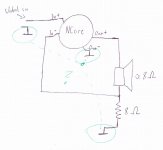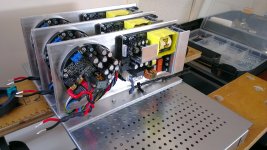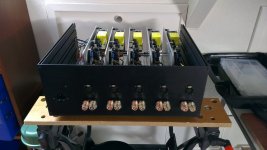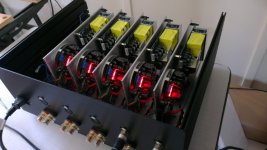"Analog, like loss of control, approximate, round in the edges", "digital, like accurate, controlled, honest"
Darn, your fingers were quicker
"Analog, like loss of control, approximate, round in the edges", "digital, like accurate, controlled, honest"
I´m afraid that is one of the rather bad translations of a way too often misused word.
Personally I wish that people would use another word than "analog" to describe their impressions as it typically leaves more questions than answers.
According to Wiki:
"Analog signal, a signal that contains information using non-quantized variances in frequency and amplitude"
In hifi its often used to describe audible attributes associated with those of turntables -leaving people to guess whether its those from the bad turntables or those from the good ones...
In either case, when I have been tweaking my turntable I don´t want it to sound more "analog". I want IT to sound less, and the Record to sound more.
"Analog, like loss of control, approximate, round in the edges", "digital, like accurate, controlled, honest"
Well here we go. With my sources, analog sounds more real than digital, but the gap slowly narrows. With hi-res digital, I may not bother to keep my LPs around.
Personally I wish that people would use another word than "analog" to describe their impressions as it typically leaves more questions than answers
I guess the use of the word stems from the early days of CDs and digital players, when people who didn't know better thought they could hear the "corners" and "graininess" of a digitized signal (just because they had seen the typical unsmoothed staircase waveform illustrations). So "analog" was supposed to be smooth, rounded, without the sharp steps in a digital signal...
Antonio,
Did the boxes come pre-drilled ??? The right chassis appears to have better wire placements than the left chassis. The power lines do not cross the signal lines and are further apart.
No I had to drill them myself.
Yes I know, the right one has a cleaner layout. Given the specular costruction I couldn't replicate that layout on the left one. But in this way I get more order and simmetry on the shelf where the audio stuff is placed.
Thank you for your answer.
Now it's little me again... I have just placed back the gain resistors for current amp test... but I wonder if my connection scheme is OK or if it's wrong:
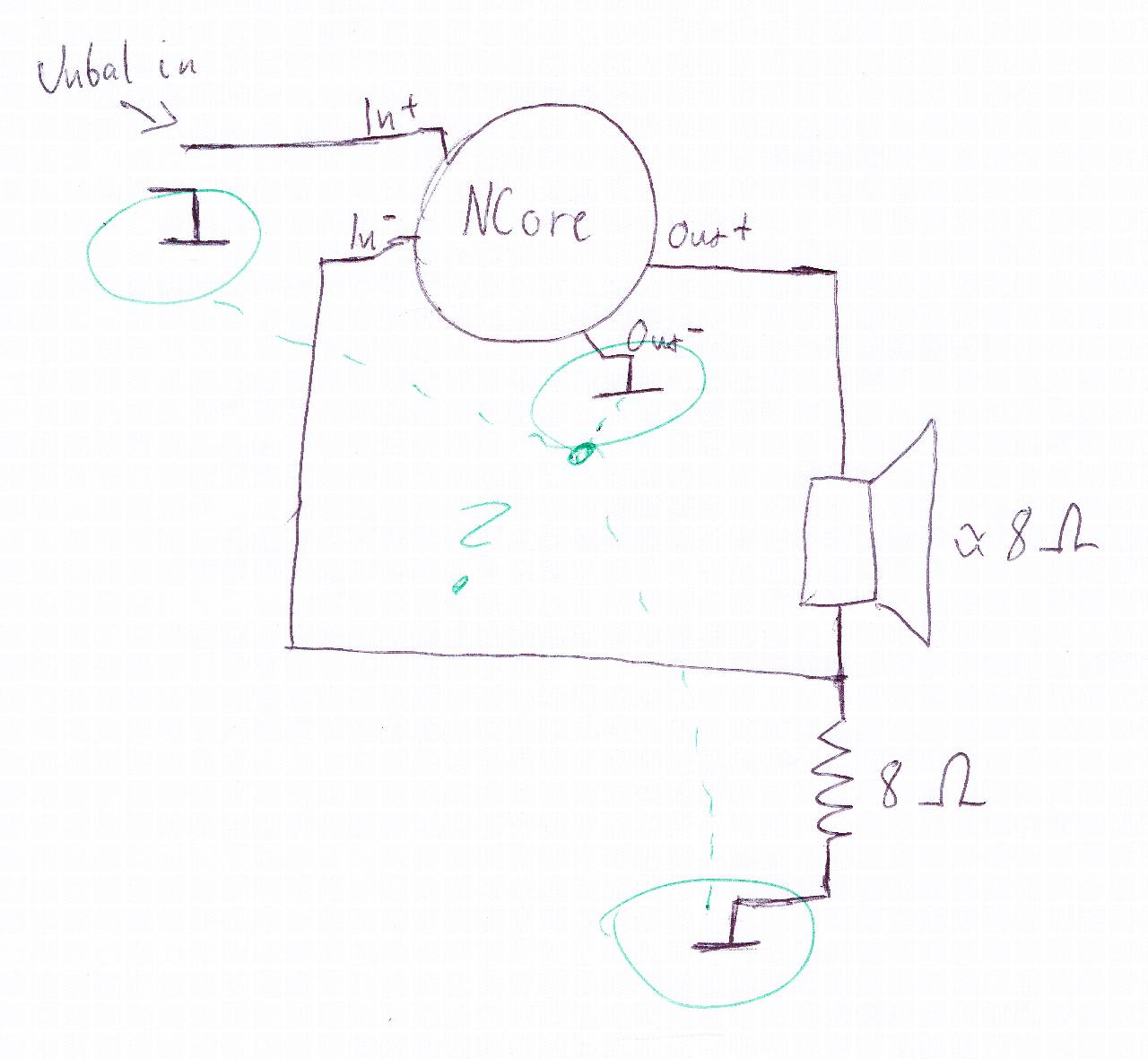
Is this how it is supposed to be, with all the green grounds connected or is something wrong?
If someone knowledgeable ( ideally Bruno ofc ) would give thumps up that it's ok and won't destroy the NCore or the speaker I promise I'll measure output impedance and do distortion sweeps on atleast one speaker to check how well it works in practice =)
Is this how it is supposed to be, with all the green grounds connected or is something wrong?
If someone knowledgeable ( ideally Bruno ofc ) would give thumps up that it's ok and won't destroy the NCore or the speaker I promise I'll measure output impedance and do distortion sweeps on atleast one speaker to check how well it works in practice =)
Attachments
Last edited:
I guess the use of the word stems from the early days of CDs and digital players, when people who didn't know better thought they could hear the "corners" and "graininess" of a digitized signal (just because they had seen the typical unsmoothed staircase waveform illustrations). So "analog" was supposed to be smooth, rounded, without the sharp steps in a digital signal...
I don't think that's quite it. Early CD players (1982-1992) just sounded horrible in the high end and they lost a lot of ambiance, imaging and detail. Of course the bass was usually impressive, there was no LP surface noise, it was cheaper and more convenient. Enthusiastically embraced by low- to mid-fi consumers. Audiophiles stuck with the LP. I bought my first CD in 1995. Over time, digital has steadily improved to the point that many audiophiles can't be bothered with LPs even if they do think analog sounds slightly better. With 24/96 recordings, I see no reason for analog recordings unless you already own them or they are unavailable in digital.
In electronics, I am a minimalist and I want my music processed as little as possible. I will ultimately listen in analog, so the less DA/AD conversion that goes on the better. If my source is analog, that means zero conversion.
Getting back to the topic of this forum, consider that a popular audiophile upgrade was to toss the SMPS and replace it with a linear PSU, despite the efficiency advantages SMPS. Part of the improvement of course was better components used in the linear PSU, but eliminating the digital nastiness in the PSU was also a significant factor.
As little as two years ago I never would have considered a class D amp (except for a sub-woofer) because of the "digital nastiness" that many complained about. Thanks to Hypex, LC Audio, ColdAMP, nuForce, and a few others, class D amps are earning a reputation of actually sounding BETTER than anything, particularly the ncore. My favorite amp of all time was a class A Threshold 400a that cooked my breakfast for me too. My second favorite amp(s) were a pair Sonic Frontiers tube monster mono-blocks that almost precipitated a divorce. My next amp will absolutely be a class D DIY (as soon as I have the money) and I expect it will be the best amp I have ever owned, not to mention the lightest and most efficient.
A year ago, I was leaning towards class D amps, but only with a linear supply. Now, it appears that SMPS design has advanced to the point where it is just as good as linear. So why not take advantage of the efficiency and weight reduction? Of course there are not many opinions of linear vs SMPS here. We know Bruno hears no advantage with SMPS and there was an unsuccessful attempt to mate a linear with supply with an ncore on this forum. I believe the vast majority of class D amp designers have selected SMPS: what does that tell you?
Still, I would be interested in the (extended) listening impressions of other members here with the ncores and hypex SMPS vs a suitable linear supply.
Bruno
Bruno. My questions is for a group of us over at AC forum.
All are based on mono blocks.
In bridged mode the NC400 puts out 600w/8ohms-1200w/4ohms and what in 2ohms?
In bridged mode how many power supplies (smps) do you use or can use per bridged modules mono blocks?
If bridged, can the NC400 drive a 2ohm load?
Also my thoughts are to run 4 Bridged mono blocks on my B&W 802D speakers. One amp for each high and low on each speaker. Would this cause any problems? The B&W are 8ohms but dip down to around 3.4ohms.
Thank you in advance for answering my questions and thank you for creating this great amp.
Al.
Bruno. My questions is for a group of us over at AC forum.
All are based on mono blocks.
In bridged mode the NC400 puts out 600w/8ohms-1200w/4ohms and what in 2ohms?
In bridged mode how many power supplies (smps) do you use or can use per bridged modules mono blocks?
If bridged, can the NC400 drive a 2ohm load?
Also my thoughts are to run 4 Bridged mono blocks on my B&W 802D speakers. One amp for each high and low on each speaker. Would this cause any problems? The B&W are 8ohms but dip down to around 3.4ohms.
Thank you in advance for answering my questions and thank you for creating this great amp.
Al.
In bridged mode how many power supplies (smps) do you use or can use per bridged modules mono blocks?
If bridged, can the NC400 drive a 2ohm load?
Also my thoughts are to run 4 Bridged mono blocks on my B&W 802D speakers. .
Hi Hifial, did you try if two NC400, one for the high and one for the low, aren't enough? I really don't understand why you would like to bridge two NC400 for the high section. Especially on speakers which have a reasonable efficiency. The drawback is that the output impedance will be doubled hence DF will decrease.
You can always buy a Mola-Mola amplifier then you have the NC1200..
Also my thoughts are to run 4 Bridged mono blocks on my B&W 802D speakers. One amp for each high and low on each speaker. Would this cause any problems? The B&W are 8ohms but dip down to around 3.4ohms.
Al.
I have listened to the ncore on the 802's, don't bother with bridging. We had plenty of sound with no approach of strain or clipping. If you wanted to use dsp or some sort of external crossover you might want to try two amps per speaker (hi lo) but I don' t see (hear) the need.
I think people don't appreciate the total change in character the ncore brings to amplification. Until it breaks up (clips) its absolutely clean. You haven't heard this before, the UCD started to approach this, but this is even more so. Look at the distortion charts, compare to other amps and you'll see what I'm getting at.
Or get the Mola Mola if you insist on more power and give Bruno and Jan their due.
Alan Garren
Well first the Mola-Mola is around $10,000 +/-, maybe more. Second the B&W 802D, while "efficient", always sounds better with more power. I have had amps that had 600w/8oms-900w/4ohm-1200w/2ohm and they would have taken more. As good as they sound with 200w/8ohm they sound better with more and it is not just my observation as many of 802D owners will tell you. They also love to be bi-amped.
In bridged mode the NC400 puts out 600w/8ohms-1200w/4ohms and what in 2ohms?
In bridged mode how many power supplies (smps) do you use or can use per bridged modules mono blocks?
If bridged, can the NC400 drive a 2ohm load?
.
Al, If you bridge NCORE´s you should theoretically get 2x(what one can do in 4ohm) in 8ohm = 800W/8ohm. (twice the voltage swing and twice the current)
In a 4 ohm load you begin to hit the current limits as you now get twice of what it can do in 2 ohm = 1200W/4ohm.
In a 2 ohm load you are definitely hitting the current limits as each module can deliver 24 A and therefore each "only" swing 24 V into the 1 ohm they "see". That should give you roughly 24*24 = 576 W RMS and 1152 W Peak for the bridged amp.
Under such conditions I would give those amps as much current capacity as they can eat, so minimum a SMPS600 each. You could also consider to feed two NOCRE´s on a SMPS1200 which should save you some money...
This means that you should only benefit power-wise in above 2ohm loads where you get a whopping 1200 W RMS in 4ohm and 800 W RMS in 8 ohm.
Whether there should be any SQ differences has yet to be reported. But if you should try to bridge, then please report your findings
cheers,
I have heard them with the B&W 802D. They are my speakers and a set of Ncore NC400 mono blocks that were loaned to me. I never said they sound strained or clipping when I have had more power and or the Ncore.
didn't mean to imply that. If you really want to know whats going on, measure the voltage being delivered to the speaker with a peak reading meter. The ones I am familiar with are the Fluke189 or 289.
With the ncore and other amps as long as you are within the voltage limits of the amp, you actually have more power for control of the speaker without bridging. The current capability is halved with bridging, and this is the area a lot of speakers "care" about. Doubling of the output impedance also goes along with this, which will double frequency response errors due to output impedance / load interaction. The way I see it, bridging is less power to the speaker, for most of the time.
If a designer was to build symetrical (ie bridging) operation into the design and incorporate the real world current needs of speakers into the design, that might be very interesting as a real (designed) push-pull system has many interesting features.
I have tried bridging independent amps in the past, was never satisfied with the results.
Alan
It's working, my 5 channel nCore. But it's getting pretty hot. Next step is fully vented cover and bottom. Sound? No! It doesn't sound. The music is just there!
That looks really nice. A very good layout....
It's working, my 5 channel nCore. But it's getting pretty hot. Next step is fully vented cover and bottom. Sound? No! It doesn't sound. The music is just there!
Awesome - that is just amazing !!
Al, If you bridge NCORE´s you should theoretically get 2x(what one can do in 4ohm) in 8ohm = 800W/8ohm. (twice the voltage swing and twice the current)
In a 4 ohm load you begin to hit the current limits as you now get twice of what it can do in 2 ohm = 1200W/4ohm.
In a 2 ohm load you are definitely hitting the current limits as each module can deliver 24 A and therefore each "only" swing 24 V into the 1 ohm they "see". That should give you roughly 24*24 = 576 W RMS and 1152 W Peak for the bridged amp.
Under such conditions I would give those amps as much current capacity as they can eat, so minimum a SMPS600 each. You could also consider to feed two NOCRE´s on a SMPS1200 which should save you some money...
This means that you should only benefit power-wise in above 2ohm loads where you get a whopping 1200 W RMS in 4ohm and 800 W RMS in 8 ohm.
Whether there should be any SQ differences has yet to be reported. But if you should try to bridge, then please report your findings
cheers,
Thank you. I will report this to the AC members that have an interest in bridging the amps.
Al.
didn't mean to imply that. If you really want to know whats going on, measure the voltage being delivered to the speaker with a peak reading meter. The ones I am familiar with are the Fluke189 or 289.
With the ncore and other amps as long as you are within the voltage limits of the amp, you actually have more power for control of the speaker without bridging. The current capability is halved with bridging, and this is the area a lot of speakers "care" about. Doubling of the output impedance also goes along with this, which will double frequency response errors due to output impedance / load interaction. The way I see it, bridging is less power to the speaker, for most of the time.
If a designer was to build symetrical (ie bridging) operation into the design and incorporate the real world current needs of speakers into the design, that might be very interesting as a real (designed) push-pull system has many interesting features.
I have tried bridging independent amps in the past, was never satisfied with the results.
Alan
Alan, I appreciate the reply. I am not the only one who has an interest in possible bridging the Ncore. Several AC members have asked about this for various systems. So, what you say about the current loss is a concern to me and that is why I asked for help from more knowledgeable people. It seems I would be better off "just" bi-amping the B&W 802D with single Ncore modules. And it cheaper too.
I will report this to the members that would have an interest in this.
Thank you, Al.
Hi,
I´ve received my NCore´s a few days ago ( 2x NCore400, 2 x SMPS600). Finished one amp yesterday (well allmost) and had a short listen. (Right channel NCore, Left Channel UCD180HG with HXR).
I can´t say a lot about the difference in sound quality but the balance left to right was still OK, no noise or hum (ca. 100dB efficient speakers). I hope to finish the second amp tonight.
What I noticed is that the NCore amp becomes a lot warmer than the UCD amp, not hot (like my Aleph-X´s) but something near 40°C.
Did anybody measure the power consumption?
William
I´ve received my NCore´s a few days ago ( 2x NCore400, 2 x SMPS600). Finished one amp yesterday (well allmost) and had a short listen. (Right channel NCore, Left Channel UCD180HG with HXR).
I can´t say a lot about the difference in sound quality but the balance left to right was still OK, no noise or hum (ca. 100dB efficient speakers). I hope to finish the second amp tonight.
What I noticed is that the NCore amp becomes a lot warmer than the UCD amp, not hot (like my Aleph-X´s) but something near 40°C.
Did anybody measure the power consumption?
William
- Status
- Not open for further replies.
- Home
- Amplifiers
- Class D
- Hypex Ncore
